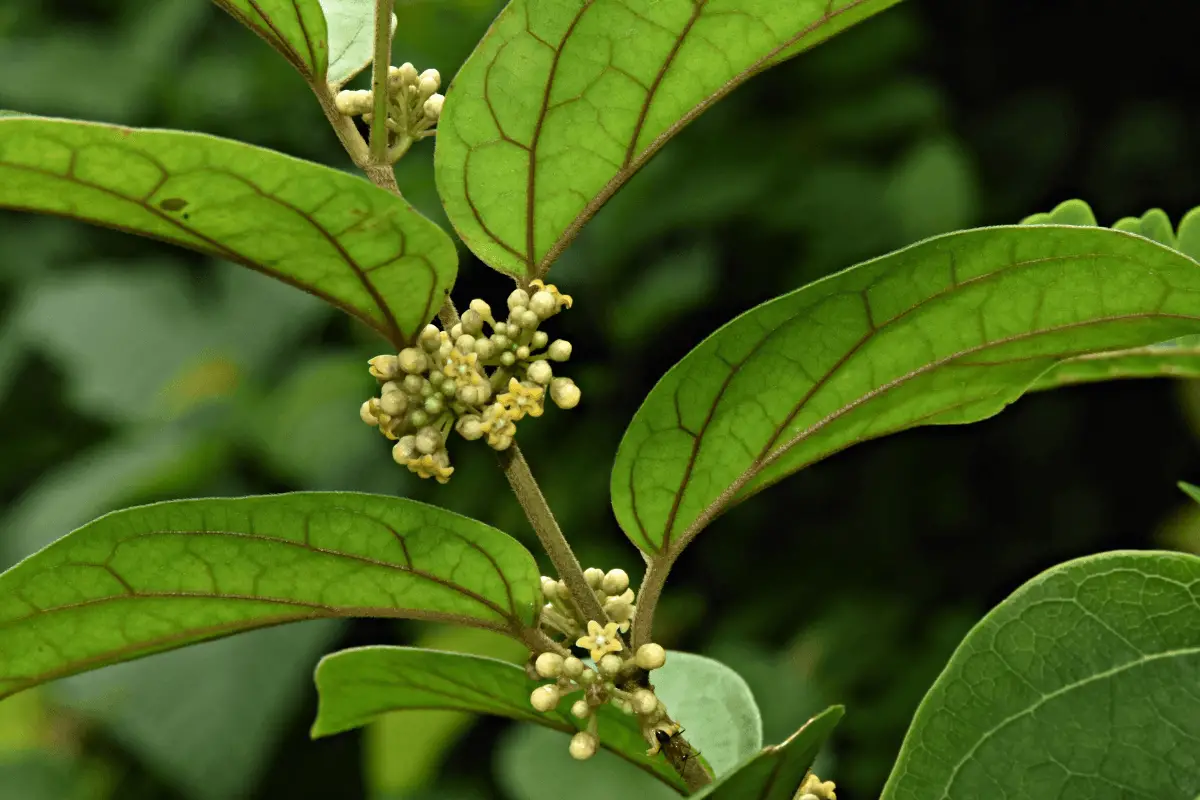Gymnema Sylvestre, also known as Australian cow plant, Buti, and Kober, is a perennial woody vine native to Asia, Africa, and Australia. This plant has been used in Ayurvedic medicine for centuries. The Hindi term “gurmar” means “sugar destroyer,” highlighting its traditional use in treating diabetes.
Gymnema Sylvestre is a plant that is known for its potential to reduce sugar cravings and improve glucose control. The plant contains chemicals that reduce how much sugar is absorbed into the bloodstream. It is also believed to stimulate the pancreas to produce more insulin, which helps the body to better regulate blood sugar levels. While research on the plant is still ongoing, some studies have shown promising results in treating diabetes and reducing sugar cravings.
Many people use Australian cow plant as a natural remedy for a variety of health conditions. It is believed to have anti-inflammatory properties and may help to reduce cholesterol levels. Some studies have also suggested that it may be effective in treating obesity and reducing body weight. As with any natural remedy, it is important to speak with a healthcare provider before using Gymnema Sylvestre to treat any health condition.
Historical Background

Gymnema Sylvestre is a medicinal plant that has been used for centuries in Ayurvedic medicine. As a part of the Indian flora, it belongs to the family Asclepiadaceae and is a woody climber. The plant is also commonly known as the Australian Cowplant.
Traditional Uses
The plant has been traditionally used in Ayurvedic medicine to treat various ailments, including diabetes, obesity, and digestive problems. The leaves of the plant are believed to have anti-diabetic properties and are used to control blood sugar levels. The plant has also been used as a natural remedy for weight loss, as it is believed to reduce sugar cravings.
Etymology and Classification
The name Australian cow plant comes from the Greek words “gymnos” and “nema,” which mean “naked” and “thread,” respectively. This refers to the plant’s thread-like appearance. The plant is also known as the “sugar destroyer,” as it is believed to reduce the taste of sweetness.
In terms of classification, Gymnema Sylvestre belongs to the family Asclepiadaceae, which is a group of flowering plants. The plant is native to Asia, Africa, and Australia and is commonly found in tropical forests.
Botanical Description

As someone who has researched Gymnema Sylvestre, I can tell you that it is a slow-growing, perennial, woody climber that belongs to the family Asclepiadaceae. The plant is native to central and peninsular India and is also found in other regions of Asia. It has highly branched stems and can climb up to the top of the tree. The leaves of the plant are elongated-oval in shape and have soft hairs on the upper surface.
Plant Characteristics
Australian cow plant has a small, yellow, umbelliferous inflorescence that is produced throughout the year. The plant is a potent antidiabetic agent and is used in folk, ayurvedic, and homeopathic systems of medicine. It is also used in the treatment of asthma, eye complaints, inflammations, and family planning.
Active Compounds
The plant contains several active compounds, including Gymnemic Acid, Saponins, Tannins, and Gurmarin. Gymnemic Acid is the most studied compound in the plant and is responsible for its antidiabetic properties. Saponins are another group of compounds found in Gymnema Sylvestre, and they have been shown to have cholesterol-lowering effects. Tannins are also present in the plant and are known for their astringent properties. Gurmarin is a peptide that is found in the leaves of the plant and is responsible for its ability to block sweet taste sensations.
Australian cow plant is a slow-growing, perennial, woody climber that is native to central and peninsular India. It has highly branched stems, elongated-oval leaves with soft hairs on the upper surface, and a small, yellow, umbelliferous inflorescence that is produced throughout the year. The plant contains several active compounds, including Gymnemic Acid, Saponins, Tannins, and Gurmarin, which are responsible for its antidiabetic, cholesterol-lowering, astringent, and sweet-blocking properties.
Health Benefits and Uses
Buti is a herb that has been used for centuries in Ayurvedic medicine to treat a variety of conditions. It has several potential health benefits that can be beneficial for people looking to improve their overall wellness.
Blood Sugar Regulation
Australian cow plant has been shown to have a positive effect on blood sugar levels. It may help reduce sugar cravings by making sweet foods taste less appealing, which can be beneficial for people with diabetes or those who are trying to manage their blood sugar levels. Additionally, it may help improve insulin sensitivity, which can help regulate blood sugar levels.
Weight Management
Gymnema Sylvestre may also be beneficial for people looking to manage their weight. It has been shown to help reduce cravings for sweet foods, which can be helpful for people looking to lose weight. Additionally, it may help reduce the absorption of fat and carbohydrates, which can help promote weight loss.
Anti-Inflammatory Effects
Gymnema Sylvestre has anti-inflammatory properties that can be beneficial for people with conditions such as arthritis and asthma. It may help reduce inflammation in the body, which can help alleviate symptoms associated with these conditions.
Cardiovascular Health
Buti may also be beneficial for cardiovascular health. It has antioxidant properties that can help reduce oxidative stress in the body, which can be beneficial for heart health. Additionally, it may help reduce cholesterol levels, which can help reduce the risk of heart disease.
Overall, Gymnema Sylvestre has several potential health benefits that can be beneficial for people looking to improve their overall wellness. It may be particularly beneficial for people with conditions such as diabetes, obesity, arthritis, and asthma. However, it is important to talk to your healthcare provider before taking any supplements to ensure they are safe and effective for you.
Gymnema Sylvestre Mechanisms of Action

As a medicinal plant, Buti has been used to treat various ailments including diabetes, obesity, and hypoglycemia. The plant contains several active phytoconstituents such as gymnemic acids, gymnemasaponins, and gurmarin, which have been identified as having various pharmacological properties.
Insulin Secretion and Production
One of the mechanisms of action of Gymnema Sylvestre is its ability to stimulate insulin secretion and production. According to a study published in the Journal of Clinical Biochemistry and Nutrition, gymnemic acids found in the plant can increase insulin secretion by inducing the regeneration of pancreatic beta cells. This regeneration leads to an increase in insulin production, which can help regulate blood glucose levels in individuals with diabetes.
Gymnema Sylvestre Sugar Absorption Inhibition
Another mechanism of action of Buti is its ability to inhibit sugar absorption in the intestines. This inhibition is due to the presence of gymnemic acids, which bind to the receptors on the taste buds responsible for detecting sweet flavors. As a result, the absorption of sugar in the intestines is reduced, which can help regulate blood glucose levels.
Regulation of Metabolism
Gymnema Sylvestre also plays a role in the regulation of metabolism. According to a study published in the Journal of Ethnopharmacology, the plant can help regulate lipid metabolism by reducing the absorption of fat in the intestines. This reduction in fat absorption can lead to a decrease in cholesterol levels, which can help prevent cardiovascular diseases.
Gymnema Sylvestre has several mechanisms of action that make it a promising medicinal plant for the treatment of various ailments. Its ability to stimulate insulin secretion and production, inhibit sugar absorption, and regulate metabolism make it a valuable addition to traditional medicine.
Gymnema Sylvestre Supplements

Gymnema Sylvestre supplements are a popular way to harness the many benefits of this herb. Buti supplements are available in various forms, including extracts, teas, pills, tablets, powders, and capsules. In this section, I will discuss the forms and availability of Gymnema Sylvestre supplements, dosage and administration, and combination with other supplements.
Buti Forms and Availability
Buti supplements are readily available in health food stores, pharmacies, and online. The supplements come in various forms, including capsules, tablets, and powders. Gymnema Sylvestre supplements are also available in combination with other supplements, such as chromium and Trigonella Foenum-Graecum.
Dosage and Administration
The dosage of Buti supplements depends on the form of the supplement. For example, the recommended dosage for a Gymnema Sylvestre capsule is 100 milligrams, taken up to four times daily [1]. It is essential to follow the manufacturer’s instructions when taking Gymnema Sylvestre supplements.
Buti Combination with Other Supplements
Buti supplements can be taken in combination with other supplements to enhance their effects. For example, Gymnema Sylvestre supplements can be taken with chromium supplements to help regulate blood sugar levels [2]. Gymnema Sylvestre supplements can also be taken with Trigonella Foenum-Graecum supplements to help reduce cholesterol and blood sugar levels [3].
Buti supplements are a popular way to harness the many benefits of this herb. The supplements come in various forms, including capsules, tablets, and powders. It is essential to follow the manufacturer’s instructions when taking Gymnema Sylvestre supplements and to take them in combination with other supplements to enhance their effects.
Gymnema Sylvestre Safety and Side Effects

Gymnema Sylvestre is generally considered safe when taken in appropriate doses. However, some individuals may experience side effects or adverse reactions. In this section, I will discuss the contraindications, cautions, and potential adverse effects of Buti.
Kober Contraindications and Cautions
Kober should not be used by pregnant or breastfeeding women. It may also interact with certain medications, such as those used to treat diabetes or high blood pressure. Individuals taking medication should consult their healthcare provider before taking Gymnema Sylvestre.
Buti Potential Adverse Effects
Buti may cause hypoglycemia, or low blood sugar levels. This is especially true for individuals taking medication for diabetes. Symptoms of hypoglycemia include shakiness, sweating, headache, and dizziness. If you experience these symptoms, stop taking Gymnema Sylvestre and seek medical attention immediately.
In rare cases, Gymnema Sylvestre may cause drug-induced liver injury or hepatotoxicity. Symptoms of liver injury include yellowing of the skin or eyes, dark urine, and abdominal pain. If you experience these symptoms, stop taking Gymnema Sylvestre and seek medical attention immediately.
While Kober is generally considered safe when taken in appropriate doses, it may cause side effects or adverse reactions in some individuals. If you experience any symptoms, stop taking Gymnema Sylvestre and seek medical attention immediately.
Gymnema Sylvestre Research and Studies

As a natural product, Gymnema Sylvestre has been the subject of many clinical trials and pharmacological research studies. These studies have explored the efficacy of the herb in treating diabetes and improving blood glucose levels, as well as its potential immunostimulatory and protein-regenerating properties.
Kober Clinical Trials
Clinical trials have shown that Kober can be an effective antidiabetic agent. In one study, participants with type 2 diabetes who took Gymnema Sylvestre extract showed a significant reduction in blood glucose levels compared to the control group. Another study found that the herb was effective in improving insulin sensitivity and reducing fasting blood glucose levels in patients with type 2 diabetes.
Pharmacological Research
Pharmacological research has also explored the potential mechanisms of action of Gymnema Sylvestre. Studies have shown that the herb can stimulate insulin secretion and improve the regeneration of pancreatic beta cells, which are responsible for producing insulin. Additionally, the herb has been found to have immunostimulatory properties, which may contribute to its antidiabetic effects.
Herbal formulations containing Kober have also been investigated for their efficacy in diabetes treatment. One study found that a combination of Gymnema Sylvestre and other herbs was effective in improving blood glucose levels and reducing oxidative stress in patients with type 2 diabetes.
Overall, the research suggests that Kober may be a promising natural product for the treatment of diabetes. However, further research is needed to fully understand its mechanisms of action and potential side effects.
Gymnema Sylvestre Consumer Information

Purchasing Tips
When purchasing Kober, it is important to ensure that the product is of high quality and from a reputable source. Look for products that are standardized to contain at least 25% gymnemic acid, the active ingredient in Gymnema Sylvestre. This will ensure that you are getting a potent and effective product.
It is also important to check the expiration date and storage instructions. Gymnema Sylvestre should be stored in a cool, dry place away from direct sunlight. Be sure to follow the recommended dosage instructions on the label and consult with a healthcare professional before use.
Usage Recommendations
Kober has been used for centuries in Ayurvedic medicine to treat a variety of conditions. It is commonly used to help regulate blood sugar levels and reduce sugar cravings. It has also been shown to have antibacterial, anti-inflammatory, and immune-boosting properties.
Consumption of Gymnema Sylvestre can help reduce the sweetness of foods and beverages, making them less appealing. This can be helpful for those looking to reduce their sugar intake or lose weight. It has also been shown to have a positive effect on low-density lipoprotein cholesterol levels.
While Kober is generally considered safe, some individuals may experience adverse effects such as diarrhea, stomach cramps, and headache. It is important to follow the recommended dosage instructions and consult with a healthcare professional before use, especially if you are pregnant or breastfeeding.
Kober is a natural supplement with a variety of potential health benefits. It can be a helpful tool for those looking to regulate blood sugar levels, reduce sugar cravings, and support overall health. However, it is important to purchase high-quality products, follow recommended dosage instructions, and consult with a healthcare professional before use.
Gymnema Sylvestre and TheHerbProf.com: A Sweet Connection!
Gymnema Sylvestre Saga: At TheHerbProf.com, we’re all about Gymnema Sylvestre! We explore its sugar-blocking properties and its role in herbal medicine.
Herbal Highlights: Learn how Gymnema Sylvestre can sweeten your herbal routine. It’s not just a plant; it’s a wellness wonder!
Culinary Creations: Gymnema Sylvestre in the kitchen? You bet! We share innovative recipes that bring out the best in Kober.
Health and Wellness: We’re all about health and wellness, and Kober is a key part of this mission. It’s packed with compounds that promote good health.
Community Connection: Join our community of Kober enthusiasts! Share your journey, learn from others, and make some new friends.
So, whether you’re a Kober guru or just starting your herbal journey, TheHerbProf.com is your trusty companion. Dive in, explore, and stay healthy!
References:
Little Herb Encyclopedia, by Jack Ritchason; N.D., Woodland Publishing Incorporated, 1995
The Ultimate Healing System, Course Manual, Copyright 1985, Don Lepore
Planetary Herbology, Michael Tierra, C.A., N.D., Lotus Press, 1988
Handbook of Medicinal Herbs, by James A. Duke, Pub. CRP Second Edition 2007
The Complete Medicinal Herbal, by Penelope Ody, Published by Dorling Kindersley
Before You Go – Check the Following Articles!
Frequently Asked Questions – Gymnema Sylvestre

What are the potential side effects of taking Gymnema sylvestre?
According to a study published on Examine.com, Kober is considered safe at doses of up to 10 g per day. The recommended daily dose of 400 mg is unlikely to produce any toxic effects. Mild side effects, such as diarrhea, stomach cramps, and headache, were reported in one study that used a dosage of 600 mg daily.
Can Gymnema sylvestre aid in weight loss, and what does the research say?
Gymnema sylvestre may help in weight loss by reducing sugar cravings and promoting healthy blood sugar levels. A study published on Buoyhealth.com suggests that Kober supplements may offer a range of potential benefits, including supporting healthy blood sugar levels, promoting weight loss, and improving digestion.
How does Gymnema sylvestre interact with liver function?
There is no evidence to suggest that Kober interacts with liver function. However, it is always important to consult with a healthcare professional before starting any supplementation.
What are the scientifically supported benefits of Gymnema sylvestre?
Gymnema sylvestre has been used in Ayurvedic medicine for centuries to treat a variety of conditions, including diabetes, inflammation, and digestive issues. Scientific studies have shown that Gymnema sylvestre may help lower blood sugar levels, reduce sugar cravings, and support weight loss. A study published on Draxe.com suggests that Gymnema sylvestre may also have anti-inflammatory and antioxidant properties.
Are there any contraindications for using Gymnema sylvestre?
Gymnema sylvestre is generally considered safe for most people. However, individuals who are pregnant, breastfeeding, or have a history of low blood sugar should consult with a healthcare professional before taking Gymnema sylvestre.
How quickly can one expect results after starting Gymnema sylvestre supplementation?
The time it takes to see results from Gymnema sylvestre supplementation may vary depending on individual factors such as diet and exercise habits. However, a study published on Verywellhealth.com suggests that taking 100 mg of Gymnema sylvestre three to four times daily may help reduce sugar cravings and promote healthy blood sugar levels within two to three weeks of consistent use.

